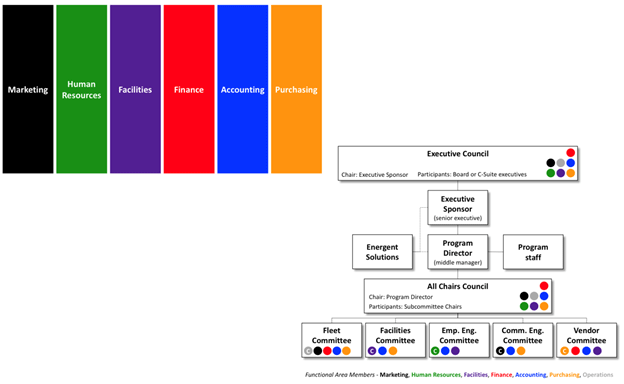You Win with People
Tip #8
By Marty Lanning, CMVP and LEED AP, Founder and CEO, Energent Solutions
Energy efficiency—or energy productivity, as some are beginning to refer to it—is not a race, but rather a journey for health care organizations. As in other areas of life, it takes a village or team to produce results.
Hospitals that have achieved tremendous success implementing energy or sustainability programs have the following three key attributes.
1. Vision
Leadership takes many styles. Some organizations build a program on cost savings, others use faith or mission to drive results, and some simply try to be good stewards of their communities. There is no right answer; neither is there a wrong answer. However, successful organizations have a stake in the ground, a stretch goal that is 5 to 10 years in the future. Skilled leaders summarize long-term goals into everyday language and rally their organizations around them.
What will be your “15 in 15” (referring to a 15% reduction in consumption in 15 years)?
2. Structure
Energy productivity is not a task that can be achieved alone. A successful program will take years to deliver on the objective.
Build a structure that creates accountability but not bureaucracy. An ideal scenario includes a central group that involves senior leadership and is tasked with focusing on the stretch goal. Each member of that central group should also lead or participate in subcommittees that promote activities such as employee engagement, recycling, and energy procurement that drive success of the overall stretch goal.

In addition to involving facility management, align contractors, utilities, purchasing, finance, hospital administration, and clinical staff to deliver results.
3. Persistence
If designed appropriately, energy programs should not create a burden on participants, but simply add focus or reward attention to detail for those involved. Most successful programs are based on incremental change or heightened focus rather than wholesale changes in operations.
About the Author
 Marty Lanning is the founder and CEO of Energent Solutions. Under his leadership, the firm helps clients optimize energy usage to create tangible cost savings and a compelling environmental story for their brand. Last year, Energent worked with one out of five Energy Star® certified hospitals in the country, including the 2017 ASHE Energy Champion Award winner. Earlier in his career, Marty worked in the business consulting division of a Big 5 accounting firm and a Fortune 100 financial services corporation , and led the sales organization for one of the fastest growing electrical services companies in the country. Marty holds a BSBA in finance from The Ohio State University and is in the process of completing his MBA at the University of North Carolina's Kenan-Flagler Business School.
Marty Lanning is the founder and CEO of Energent Solutions. Under his leadership, the firm helps clients optimize energy usage to create tangible cost savings and a compelling environmental story for their brand. Last year, Energent worked with one out of five Energy Star® certified hospitals in the country, including the 2017 ASHE Energy Champion Award winner. Earlier in his career, Marty worked in the business consulting division of a Big 5 accounting firm and a Fortune 100 financial services corporation , and led the sales organization for one of the fastest growing electrical services companies in the country. Marty holds a BSBA in finance from The Ohio State University and is in the process of completing his MBA at the University of North Carolina's Kenan-Flagler Business School.
Have a tip you want to share? We’d love to hear from you. Contact Kara Brooks at kbrooks@aha.org.

